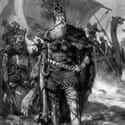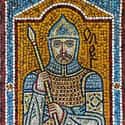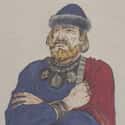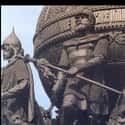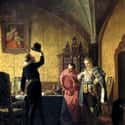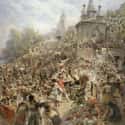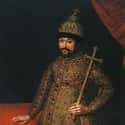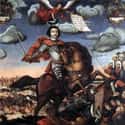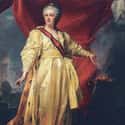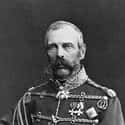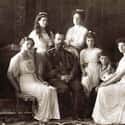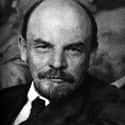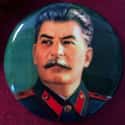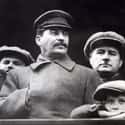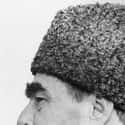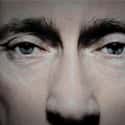-
(#1) 862 - 882: Rurik State
Leader: Rurik
Known for: Establishment of the Rurik state based in Novgorod, foundation for the Rus Dynasty
Rurik was a Viking or Varangian who was either invited by the inhabitants of Novgorod to rule in 862 or captured the city during the 860's. Due to conflicting reports and inconsistencies regarding record keeping, a lot about Rurik's reign is unclear and some historians doubt he existed at all. Regardless of how it came to be, the Rurik Dynasty was a legitimate Russian government system.
Rurik and his two brothers allegedly established themselves in the region, creating the first Russian state. When Rurik died in 879 CE, he gave the city and region to Oleg, his kinsman. He also entrusted his son, Igor, to Oleg.
-
(#2) 882 - 1240: Kievan Rus Dynasty
Key Leaders: Oleg, Igor, Olga, Svyatoslav, Vladimir I
Known for: Capture of Kiev, establishment of the first Kievan Rus law code, introduction of Christianity, early battles with the Mongols
Oleg and his successors - Igor (allegedly the son of Rurik), Igor's wife Olga, and their son Svyatoslav - consolidated control of the area around Kiev during the 10th century. During the reign of Igor's grandson, Vladimir, Christianity was introduced and the Rus control over Kiev was solidified. The lands were organized into a confederation of states based in nearby cities and led by Vladimir's sons.
Vladimir created a hierarchy of sorts and a patterns of succession involving younger brothers and nephews replacing deceased leaders throughout the various territories. The eldest son was the Grand Prince (sometimes called the Grand Duke) of Kiev. Through the eleventh, twelfth, and part of the thirteenth centuries, Kiev carried out military battles and engaged in trade activities, extending their sphere of influence south to the Baltic Sea. However, there were tensions involving the order of succession. Princes sometimes attempted to seize power instead of waiting their turn and territories occasionally rejected their given leader.
During the thirteenth century, the Princes came into increasing contact with the Mongols. At the Battle of Kalka River in 1223, the Mongols made their first attempt to invade Russia and destroyed the Kievan army.
-
(#3) 1240 - 1271: Mongol Domination And The Golden Horde
Key Leaders: Batu Khan
Known For: Mongol sack of Kiev, establishment of the Golden Horde, a shift to feudalism
Batu Khan, the grandson of Genghis Khan, finally seized Kiev in 1240 and broke up the dynasty of the Rus. The Mongols established a capital at Sarai on the Volga River, but they stationed men in every town. The Mongol state established during this time came to be known as the Golden Horde, and lasted until the end of the fifteenth century.
The center of administrative and cultural life in Russia shifted from Kiev to Moscow. The Mongols worked with the local leadership, including the Grand Princes, but maintained an overlordship and collected taxes while remaining culturally distinct.
The Golden Horde dramatically changed the social structure in Russia, especially for working class peasants. Peasants were forced to give up their crops to their respective princes or Mongol overlords. This created a feudal system, with many of the working class effectively becoming serfs of the ruling class in return for stability and protection.
-
(#4) 1283 - 1533: End Of Mongol Rule And Establishment Of An Aristocracy
Key Leaders: Dimitri Donskoy, Vasily I, Vasily II, Ivan III, Vasily III
Known For: Reasserting dominance over the Mongols in 1389 and the establishment of an aristocracy
With the growth of Moscow under the Mongols, the princes there grew in authority and became known as Grand Princes or Grand Dukes like their early predecessors at Kiev. The Mongols were happy to let the Grand Dukes exist with a fair amount of autonomy as long as they got their taxes. Beginning in the late fourteenth century, the Grand Duke was made by heredity rather than Mongol choice. In 1389, Grand Duke Dimitri Donskoy asserted his son would succeed him, ending 150 years of Mongolian dominance.
Over the fourteenth and early sixteenth centuries, the Grand Dukes of Moscow established a stable line of succession and consolidated power. Vasily II, Ivan III, and Vasily III all used military might to extend the authority of the Grand Dukes of Moscow to independent principalities like Novgorod. Slowly, the Grand Dukes of Moscow converted their rule over their subjects to an autocracy.
-
(#5) 1533 - 1581: Rise Of Ivan The Terrible And Establishment Of The Tsar System
Key Leaders: Ivan IV
Known For: Establishment of the tsar in 1547 and beginning of widespread government surveillance
After amassing a personal fortune and conquering several rivals, Ivan IV became the Grand Duke of Moscow in 1533. Known as Ivan the Terrible, he was prone to violent outbursts and used ruthless military tactics to push back the Mongols and reconquer ancient Russian lands. In 1547, he was crowned the "tsar of all Russia." As tsar, Ivan minimized the power of the noble class, took dictatorial power over the area surrounding Moscow, and punished traitors and law breakers severely.
The system of justice under Ivan IV, the Sudebnik, clearly defined laws and punishments while eliminating corruption and judicial misconduct. Ivan also created the Oprichniki, the first secret police in Russia. The Oprichniki rode through Russia on black horses with saddles emblazoned with a symbol of a broom and a dog's head. The broom signified Ivan's intention to sweet Russia of corruption and the dog's head was a reminder the czar was always watching.
-
(#6) 1581 - 1605: End Of Rurik Dynasty And Rise Of False Dmitri
Key Leaders: Feodor I, Boris Godunov, Feodor II, False Dmitri I
Known For: The end of the Rurik Dynasty and the beginning of the Time Of Troubles
Towards the end of his reign, Ivan IV became increasingly hostile and erratic. He married five wives through the 1570's, but only produced one son suited to serve as his successor. However, Ivan IV murdered that son in 1581. This set the course for a series of events known as the Time of Troubles, lasting roughly from 1598 to 1613.
Ivan's son Feodor, eventually became the new tsar, but was considered feeble-minded and ill-suited as a ruler. He was largely a figurehead during his reign and, upon his death at 40, Ivan IV's family had no remaining heirs to the throne. Boris Godunov, Feodor I's former guardian, became the new tsar. In the early 1600's, droughts and famines caused political turmoil throughout Russia. After Godunov's sudden death, things only got worse when his son, Feodor II, assumed the role of tsar.
In 1605, A man known as "False Dmitri" claimed to be Ivan IV's son and therefore the rightful heir to the throne. Ivan IV's son, Dmitri, had been stabbed to death under mysterious circumstances at the age of 9 and a half, but False Dmitri claimed he had actually escaped the attack and been on the run. Despite the dubious nature of his claims, False Dmitri gained a considerable following. He eventually stormed Moscow with an army, assassinating Gudunov's wife and Feodor II and assuming power as the new tsar.
-
(#7) 1605 - 1613: The Time Of Troubles
Key Leaders: False Dmitri I, Vasily Shuisky
Known for: The Polish-Muscovite War, a declaration of war from Sweden, and a lack of a clear ruler or governmental system
The Time of Troubles continued with the reign of the first False Dmitri. He became an incredibly controversial ruler due to his marriage to a Polish Catholic woman and refusal to attend Eastern Orthodox Church. False Dmitri's reign lasted for less than a year. A muscovite prince, Vasily Shuisky, eventually overthrew and executed False Dmitri with the assistance of Russian nobles. Many of False Dmitri's Polish supporters were murdered as well.
Shuisky's reign proved short-lived, as yet another man came forward claiming to be Ivan IV's murdered son Dmitri. Shuisky signed an alliance with Sweden while the second false Dmtitri also gained support from the Roman Catholic Poland. This eventually resulted in the Polish-Muscovite War from 1605 to 1618, in which Shuisky was eventually forced to abdicate.
However, the second false Dmitri did not immediately take the throne as Poland presented Władysław IV Vasa, then prince of Poland, as a rival candidate. Vasa did serve as tsar of Russia, but widespread mistrust of Polish rule and a resentment of the rise of Roman Catholicism led to more wars and uprisings. Sweden, then rivals of Poland, outright declared war on Russia and the country struggled to establish a concrete government system. During this time period, there was no clear ruler of Russia and the country fell into political and economic turmoil.
-
(#8) 1613 - 1689: Tsarist Rule Under The Early Romanovs
Key Leaders: Fyodor Nikitich Romanov, Michael Romanov
Known For: Restoration of order under the Romanov Dynasty, which lasted from 1613-1917
The Time of Troubles ended when the last of the Poles were driven out of Moscow and the assembly of the land (zemski sobor) came together to elect a new tsar. Michael Romanov was a distance relative of Feodor I, the last of the Rurik line, and was released from captivity and co-ruled with his mother's family.
Michael was assisted by his father, Fyodor Nikitich Romanov, during his reign. Fyodor had been banished to a monastery during Boris Godunov's reign, but was released after Godonov's death and made patriarch of Russia during Michael's reign. Fyodor and Michael restored order to Russia and used the assembly of the land to strengthen the institution of serfdom, reform local government, and centralize tsarist authority.
-
(#9) 1689 - 1725: Imperial Russia And The Rule Of Peter The Great
Key Leader: Peter The Great
Known For: Modernization of Russian institutions, moving the capital of Russia to St. Petersburg, building Russia to be a competitor in European and World politics
Peter the Great, born Peter Alexeyevich Romanov, implemented military, government, administrative, and cultural reforms during the late seventeenth and early eighteenth centuries that transformed Russia into a major imperial power. Peter implemented a standing army in Russia with formal training and discipline. He grew the navy as well and used his military to extend the Russian empire into Estonia, Latvia, and Finland.
Through his reform of the tax system in Russia, he was able to pay for these changes. He did away with the land and household tax, replacing them with a head tax. This took the tax burden off of the landowners and distributed it to the entire population. He reorganized the states within Russia into eight governorates, each with a group of civil service workers administering the area.
Culturally, Peter ventured out on a tour of Europe and brought back technology, industry, dress, and even a shaven face to Russia to bring the nation on par with Western Europe. Peter also introduced the Table of Ranks to define nobility and hierarchy by implementing a system of merit rather than birthright and genealogy.
-
(#10) 1762 - 1796: Rule Of Catherine The Great
Key Leader: Catherine the Great
Known For: Extension of the Russian Empire
Sophie Friederike Auguste von Anhalt-Zerbst took the name Catherine when she became a member of the Russian Orthodox Church in 1745. She married into the Romanov family when she married Peter the Great's grandson, also named Peter, during the same year. When Peter became Tsar Peter III in 1762, he was quickly overthrown during a revolt and Catherine was put into the position of Empress.
As the leader of Russia, Catherine waged a series of wars against Poland, her native land, and the Ottoman Empire. During her tenure, the Russian empire expanded from the Black to the Baltic Seas, adding 200,000 square miles to Russian.
Her attempts to reform law and incorporate Enlightenment ideas into Russian culture and politics were less successful than her military endeavors. While she intended to emancipate the serfs, this was an impractical economic and political move and, instead, she imposed serfdom in previously free areas like the Ukraine.
Overall, her rule increased the repression of peasants but she also built new towns, cities, funded cultural projects, expanded trade and communications, and implemented administrative reforms in the individual provinces of Russia.
-
(#11) 1796 - 1812: Defeat Of Napoleon And Beginning Of Social Reform
Key Leaders: Alexander I, Nicholas I, Alexander II
Known For: Defeat of Napoleon, social reformAfter Catherine the Great, leadership in Russia faced internal opposition by the peasantry and nobility alike. Catherine's son and successor, Paul I, was tsar briefly from 1796 to 1801 until an angry aristocracy staged a revolt and assassinated him. His son Alexander became Tsar Alexander the I and ruled until 1825.
Alexander I spent his early years as tsar pushing domestic reforms, determined to end the centralized Russian system. He was heavily influenced by Enlightenment thinkers and developed plans for a representative body called the Duma. He also defeated Napoleon Bonaparte when the French invaded Russia in 1812, boosting Alexander's reputation on the global stage while seriously hindering Napoleon's quest for empire. Later in his reign, Alexander largely lost interest in reform.
-
(#12) 1812 - 1905: The Last Of The Tsars And Bloody Sunday
Key Leaders: Alexander II, Nicholas I, and Alexander III
Known for: Devolvement of the tsar system
Alexander lost interest in reforms later in his reign and his successor, Nicholas I, had no interest in change at all. Nicholas I (reigning from 1825-1855) was autocratic and used his military and bureaucracy to carry out his every whim.
When Alexander II became tsar in 1855, he again returned to the idea of reform, specifically with the emancipation of the serfs, a new law code, and local governmental, taxation, and police change. After Alexander II's death in 1894, his son Alexander III became tsar and, once again, went more autocratic in his rule.
Alexander III was followed by Nicholas II who struggled to hold on to the position until 1917. He effectively lost control of the government in 1905 "Bloody Sunday" revolt. When soldiers opened fire on unarmed protestors, public outrage forced Nicholas II to promise reforms. This led to the establishment of a constitution and forced Nicholas II to start a Duma to create new legislature.
-
(#13) 1905 - 1917: The Duma, Constitutional Reform, And The Introduction Of Communism
Key Leaders: Nicholas II
Known For: End of the tsarist government, establishment of Communist RussiaThe Russia Duma was in place from 1906 to 1917, but was ineffective in bringing reform to fruition. A series of dumas met over the next decade, many of them dissolved by the tsar due to their liberal agendas. In the end, the Duma established a new provisional government and Nicholas II abdicated the throne.
The provisional government attempted to establish universal suffrage, elections for all government officials, and equality for all, but lacked the authority and cohesiveness to get any legislation passed. It lasted for only eight months before Vladimir Lenin and the Bolsheviks seized power in October 1917.
-
(#14) 1917 - 1924: Civil War And Communism Under Lenin
Key Leader: Vladimir Lenin
Known For: Establishment of Communist government in Russia
In October 1917, Vladimir Lenin and the Bolsheviks seized power in Russia by staging a coup against the Provisional Government. Lenin took over as dictator but civil war broke out soon after. Bolsheviks, the Communists known as Reds, fought against remaining loyalists to the tsarist tradition, democratic socialists, and capitalists in Russia, collectively known as the Whites.
The Reds defeated the Whites and Lenin embarked on his plan to reform Russia. The Bolsheviks, who eventually became the Communist Party, first practiced War Communism, a radical economic system employed during wartime. Under war communism, grain was taken from the peasantry to support the Bolsheviks. Private trade became illegal and money was abolished.
War Communism was a failure and depleted Russia. In 1921, Lenin put his New Economic Policy (NEP) into effect. The NEP revived the Russian economy by encouraging industry and easing quota and tax burdens on the peasantry. The NEP eased national control of small-scale markets and allowed for the resurgence of a capitalist class. By the time Lenin died in 1924, there were fears that Communist Russia had let too many outside interests back into the economy and the country.
-
(#15) 1924 - 1953: Rise Of Stalinist Russia And The USSR
Key Leader: Josef Stalin
Known For: Collectivization, the Great Terror
After Lenin died, Josef Stalin, the General Secretary of the Communist Party, and Leon Trotsky, the head of the Red Army, competed for control of Russia. Stalin won out by eliminating all of his rivals. He exiled and murdered his naysayers and competitors, completely seizing power and declaring himself dictator in 1929.
During the late 1920s and early 1930s, Stalin implemented his First Five Year Plan, which forced industrialization and collectivized agriculture - essentially undoing Lenin's NEP. Collective farming was unpopular among the peasantry and unsuccessful in meeting the needs of Russia, but industry grew and transformed Russia into an increased urban society. Heavy industry was emphasized over all other aspects of economy and life in Russia.
-
(#16) 1936 - 1953: The Great Terror And Rise Of The Soviet Union As A Super Power
Notable leaders: Josef Stalin
Known for: Death of millions of Russian citizens, Russia's involvement in World War II, expansion of the Soviet Empire
From 1936-1939, Stalin carried out his "Great Terror" by staging trials for Communist Party and Red Army members as well as anyone else that he feared were conspiring against him. Stalin killed, exiled, and imprisoned millions of Russians during the Great Terror.
Communist Russia signed a non-aggression pact with Hitler and Nazi Germany in 1939. When the Nazis violated that and invaded in 1941, Russia joined the Allies in World War III. Soon after the war, Russia and the United States emerged as the world's superpowers, ushering in the Cold War.
The Soviet Union's sphere of influence extended throughout Eastern Europe with governments that were dependent upon Moscow formed in Poland, Czechoslovakia, Hungary, Romania, and Bulgaria in 1948. The soviets, or local or regional governmental bodies under the control of Moscow, made up the growing Union of Soviet Socialist Republics, the USSR.
-
(#17) 1953 - 1989: The USSR After Stalin And The Cold War
Key Leaders: Nikita Kruschev, Leonid Brezhnev, Mikhail Gorbachev
Known For: Détente, Brezhnev Doctrine, Perestroika, Glastnost
The Cold War lasted through to the end of the 1980s and was characterized by competition between the US and Russia in politics, technology, weaponry, international influence, and economic development. Under Nikita Khrushchev, who served as Russian premiere from 1958 to 1964, the Soviet Union generally espoused peaceful coexistence with the West. There were periods of high tension between the US and Russia, including the Bay of Pigs invasion and the Cuban Missile Crisis of the 1960s, but there were also periods of détente, when tensions "thawed."
In 1977, a new constitution was put into place, clearly delineating the role of the governments in the USSR and those in the individual republics and laying out a process by which republics could secede from the USSR.
When Mikhail Gorbachev became General Secretary of the Communist Party and leader of the Soviet Union in 1985, he adopted the two policies of glasnost, or openness, and perestroika, or restructuring. Gorbachev opened up the USSR to criticism internally and eased governmental control of the individual soviets as well as restructured the leadership of the Communist party and the economic structure of the USSR. In 1988, he continued his reforms opening the USSR up to the idea of democratic elections.
In 1989 and 1990s, the elections in the soviets proved to be the undoing of the USSR, with Communist candidates losing in Poland, Bulgaria, Romania and other republics. East Germany was lost to the Communists and Germany was reunified in 1990, with the Berlin Wall, a symbol of the Iron Curtain of Communism, coming down.
-
(#18) 1991 - Present: The Russian Federation And Independent States
Key Leaders: Boris Yeltsin, Vladimir Putin
Known For: Establishment of the Russian RepublicMikhail Gorbachev resigned his position in 1991 and was replaced by Boris Yeltsin, who became the first elected President of an independent Russian state. The USSR formally broke up and the Soviet states each established themselves as new, independent countries during the early 1990s, many of which later joined the Commonwealth of Independent States. The government in the Russian Federation, the largest of the republics to come out of the former Soviet Union, began a series of economic reforms by opening Russia up to the free market.
Yeltsin faced opposition from the Russian parliament and he dissolved the body in 1993, calling for new parliamentary elections. Russia invaded Chechnya in 1994, the first of several wars to try to bring the break-away republic back under Russian control and a cease fire was agreed to during Yeltsin's second term. The conflict with Chechnya continued until 2009.
Yeltsin was replaced by Vladimir Putin in 2008, who led Russia for eight years, was succeeded by his protege Dmitry Medvedev (Putin was Medvedev's prime minister), and was then re-elected to the presidency in 2012. Under both Putin and Medvedev, Russia there are outcries about voter fraud, raising questions about how legitimacy of free elections in Russia.
New Random Displays Display All By Ranking
About This Tool
In Russia's thousand-year history, turmoil and crisis seem to be the norm in Russian society. Looking back at the time from the Kievan Rus era to Putin's administration, the Russian government system has undergone tremendous changes. From the early Mongolian invasion to the Tsarist regime to the Soviet system, to the revolution becoming a presidential republic. Russia's development history is full of turbulence and crisis, and it is constantly changing and improving.
Russia is not only famous for its strong national power and the rise of its political system, but also for its various artistic and cultural contributions, such as ballet, Tolstoy, Tchaikovsky, vodka, etc. The random tool introduced 13 government systems in Russian history.
Our data comes from Ranker, If you want to participate in the ranking of items displayed on this page, please click here.











